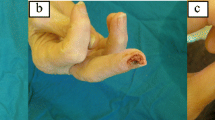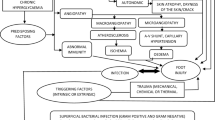Abstract
The management of ulcers is a real challenge for physicians and nurses. In systemic sclerosis (SSc), the treatment of digital ulcers (DU) should improve tissue integrity and viability, promote ulcer healing, and reduce the formation of new DU. Wound healing is a complex process regulated by a pattern of events including coagulation, inflammation, formation of granulation tissue, epithelialization, and tissue remodeling. The observation of the ulcer characteristics is fundamental to choose the strategy, and a multidisciplinary approach is required, including both systemic and local treatment, using a combination of non-pharmacological care, antibiotics if an infection is suspected, and surgical intervention in most severe cases. Furthermore, educational aspects are of paramount importance.
The structured approach to management of chronic wounds in SSc is represented by wound bed preparation (WBP) that includes different steps as detersion and debridement (passive debridement, active debridement, selective debridement, nonselective debridement, and maintenance debridement). The removal of foreign material and devitalized or contaminated tissue from or adjacent to the lesion is important because it is well known that tissue necrosis and slough may release cytokines that can frequently determine pain and worsen the status of DU. Debridement can be achieved through surgical, enzymatic, autolytic, mechanic, or biological methods. New research on wound care has focused on the “advanced” dressings that can help the operator with difficult/chronic lesions. These products are able to trigger the healing process of a lesion during the different phases, keeping a moist environment in the lesion. There are more than 1000 different dressings to choose in the different stages of the ulcers including transparent film dressings, barrier cream, oil solution fatty acids, hydrogel, non-adherent dressing, hydrocolloid dressing, polyurethane foams, alginate, hydrophilic dressing, collagen and cellulose dressing, hyaluronic acid dressing, modulators of protease metal, hydrophobic dressings for controlling bacterial charge, and dressings with silver. Obviously, infections necrosis and gangrene can complicate the scenario. For this reason, the physician must foster vascularization as much as possible, while the nurse will choose the most appropriate dressings for the wound characteristics. This combined approach may significantly accelerate wound healing and improve the quality of life of SSc patients.
Access this chapter
Tax calculation will be finalised at checkout
Purchases are for personal use only
Similar content being viewed by others
References
Goss JR. Regeneration versus repair. In: Cohen IK, Diegelmann RF, Lindblad WJ, editors. Wound healing biochemical and clinical aspects. Philadelphia: WB Saunders; 1992. p. 40–62.
Korn JH, Mayes M, Matucci Cerinic M, et al. Digital ulcers in systemic sclerosis: prevention by treatment with bosentan, an oral endothelin receptor antagonist. Arthritis Rheum. 2004;50:3985–9.
Ferri C, Valentini G, Cozzi F, et al. Systemic sclerosis: demographic, clinical, and serologic features and survival in 1,012 Italian patients. Medicine. 2002;81:139–53.
Denton CP, Korn JH. Digital ulceration and critical digital ischaemia in scleroderma. Scleroderma Care Res. 2003;1:12–6.
Botzoris V, Drosos AA. Management of Raynaud's phenomenon and digital ulcers in systemic sclerosis. Joint Bone Spine. 2011;78:341–6.
Barr WG, Robinson JA. Systemic sclerosis and digital gangrene without scleroderma. J Rheumatol. 1988;15:875–7.
Chung L, Fiorentino D. Digital ulcers in patients with systemic sclerosis. Autoimmun Rev. 2006;5:125–8.
Korn JH. Scleroderma: a treatable disease. Cleve Clin J Med. 2003;70:954–8.
Denton CP, Black CM. Scleroderma and related disorders: therapeutic aspects. Baillieres Best Pract Res Clin Rheumatol. 2000;14:17–35.
Steen V, Denton CP, Pope JE, Matucci-Cerinic M. Digital ulcers: overt vascular disease in systemic sclerosis. Rheumatology (Oxford). 2009;48(Suppl 3):iii19–24.2.
Abraham S, Steen V. Optimal management of digital ulcers in systemic sclerosis. Ther Clin Risk Manag. 2015;11:939–47.
Schiopu E, Impens AJ, Phillips K. Digital ischemia in scleroderma spectrum of diseases. Int J Rheumatol. 2010;2010:1.
Kowal-Bieleck O, Fransen J, Avouac J, et al. Update of EULAR recommendations for the treatment of systemic sclerosis. Ann Rheum Dis. 2017;76:1327–39.
Giuggioli D, Manfredi A, Vacchi C, Sebastiani M, Spinella A, Ferri C. Procedural pain management in the treatment of scleroderma digital ulcers. Clin Exp Rheumatol. 2015;33:5–10.
Moffatt CJ, Franks PJ, Hollinworth H. Understanding wound pain and trauma: an international perspective. EWMA Position Document: Pain at wound dressing changes; 2002.
Hollinworth H. Pain and wound care. Wound care society educational leaflet. Wound Care Society: Huntingdon; 2000.
Braschi F, Bartoli F, Bruni C, Fiori G, Fantauzzo C, Paganelli L, De Paulis A, Rasero L, Matucci-Cerinic M. Lidocaine controls pain and allows safe wound bed preparation and debridement of digital ulcers in systemic sclerosis: a retrospective study. Clin Rheumatol. 2017 Jan;36(1):209–12.
International consensus. Per un uso corretto delle medicazioni all’argento nelle ferite. Consenso di un panel di esperti. London: Wounds International; 2012. http://www.woundsinternational.com/media/issues/588/files/content_10495.pdf
Fonder MA, Lazarus GS, Cowan DA, Aronson-Cook B, Kohli AR, Mamelak AJ. Treating the chronic wound: a practical approach to the care of nonhealing wounds and wound care dressings. J Am Acad Dermatol. 2008;58:185–206.
Fiori G, Galluccio F, Braschi F, Amanzi L, Miniati I, Conforti ML, et al. Vitamin E gel reduces time of healing of digital ulcers in systemic sclerosis. Clin Exp Rheumatol. 2009;27:51–4.
Author information
Authors and Affiliations
Editor information
Editors and Affiliations
Rights and permissions
Copyright information
© 2019 Springer Nature Switzerland AG
About this chapter
Cite this chapter
Bellando-Randone, S., Pucci, T., Rasero, L., Denton, C.P., Matucci-Cerinic, M. (2019). Wound Dressing for Digital Ulcers in Systemic Sclerosis. In: Matucci-Cerinic, M., Denton, C. (eds) Atlas of Ulcers in Systemic Sclerosis. Springer, Cham. https://doi.org/10.1007/978-3-319-98477-3_19
Download citation
DOI: https://doi.org/10.1007/978-3-319-98477-3_19
Published:
Publisher Name: Springer, Cham
Print ISBN: 978-3-319-98475-9
Online ISBN: 978-3-319-98477-3
eBook Packages: MedicineMedicine (R0)




